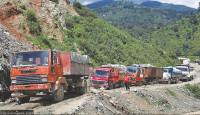Opinion
No easy way out
We were lucky this time around, with a functioning airport and no major highway disruptions
I think of myself as a layman on the topics I usually write about. I know even less about earthquakes, but had still penned a piece, ‘Rain of Bricks’, in 1994. Possibly, because of the title, it got mentioned in the book Everest: Mountain without mercy. Unfortun-ately, merciless nature manifested in terms of avalanches on the mountain, as did the toppling of many brick structures, just before noon, following a high intensity April 25 earthquake.
The quake was overdue and scribes had made their writing as apocalyptic as possible to sensitise the general public. Still, the firsthand experience of the 7.9 Richter scale jolt was truly horrific. It was more like the coming of a storm, accompanied by the ground shaking and everything that stood on it creating a strange, unpleasant noise all around. But the quake ended up not being as disastrous as assumed, especially since it occurred in broad daylight and on Saturday. This was the best combination for an event as frightening. That said, it was ultimate devastation for many whose worlds came crashing down as they lost family members, the houses they lived in, or both.
TIA’s burden
As for aviation, the only thing exciting amidst the gloom was the first-ever arrival of a Boeing 787 and even the newer Airbus 350 with relief materials. Another equipment of interest was the V-22 Osprey, sent by the US. The Osprey is essentially a ‘two in one’—a fixed wing and a helicopter—bundled into one. Developed following the Iran rescue debacle of 1979, it was designed purely for military rescue missions. As reports in local newspapers go, the V-22 had problems working in our terrain and altitude. Other helicopters like Mi17s are engaged in relief works with far less hassle.
Given the inadequacy of infrastructure, Tribhuvan International Airport (TIA) happens to be chaotic even during normal times. Imagine what it must have been like with unloaded relief materials taking up much of the airport space. Huge aircraft were unable to make a quick turnaround with 10-15 approaching aircraft holding for hours for uncertain landing turns. In an extreme example, one passenger aircraft was kept holding in the air for a total of six hours, including that of the second attempt, and still headed back to the very place it departed in the morning! In another instance, one arriving passenger described how they were made to wait for two-and-a-half hours before being allowed to deplane.
Another airport?
Hypothetically pondering, I wonder if an airport at Nijgadh would have helped. Being a green field airport, it possibly would have longer and better quality runways to handle heavies. It would undoubtedly have adequate number of parking bays and separate cargo loading and unloading areas. But for Nijgadh, an effectively functioning ‘fast track’ capable of withstanding major quakes, is the prerequisite.
We should seriously think about our infrastructure upgrade to avoid future bottlenecks in such events. As the relief supplies would still need to be moved to the interior, helicopters become an integral part of such operations. Lack of delivery capability was the biggest bottleneck at TIA in this instance.
For the time being, it will be prudent to explore possibilities of having separate cargo offloading and storage areas at TIA. It would be best if this can be accommodated within the present airport precinct. Suitable areas can be seen in the south west direction from the end of Runway 20. There may be even better options. With the Nijgadh project on uncertain hold,
it is time to prioritise improvement options for TIA, with disaster aspects in mind. We were lucky, this time, with a functioning airport and no major highway disruptions. At the operational level, TIA needs to seriously re-think opting for unidirectional operation, allowing only north-bound take-offs and landings to reduce runway occupancy and holding time in the sky. Perhaps completion of the 300 metre runway length increase will help make this possible.
Equally, it would be wise to have at least one multipurpose big open space to handle future disaster-related works in each hill district. Such areas must be flat enough to allow the operation of big helicopters. They also must have an adequate big covered area for the safe storage of supplies. During normal times, such areas can be used for a variety of district-centric events like exhibitions, or as sports venues. They could be turned quickly to disaster relief works if so required.
A high rise tangent
I trust that a little digression into the urban realm will not be out of tune here. Kathmandu and its urban periphery will continue to grow towards the base of the hills as the Valley’s river plains gets filled. Thanks to policy reversal following the first Janaandolan, the opening up of construction activities on the lowlands stands as a blatant example of manipulation to serve vested interest. Weak monitoring and enforcement capabilities were compounded by the greed of owners who often took policy measures as unwarranted impediments against their interests.
The sorry state of most high rise apartments stand as testament to short-term profit motives sans safety concerns. Owners are even rumoured to have instructed consultants not to recommend ‘pile foundation’ as this would add ‘unnecessary’ costs to the project. Consultants were supposedly even warned of expulsion if they did not comply. Incidentally, this particular high rise is believed to be the worst hit, with many of its wantonly duped occupants left in the lurch.
Hopefully, we have learnt a valuable lesson at considerable cost about the lack of preparedness and the laxity of enforcements driven by greed. Minimising suffering with disaster preparedness and management should be the core principle of every infrastructure endeavour from now on. It will be difficult, but this is the only way out.




 19.12°C Kathmandu
19.12°C Kathmandu









